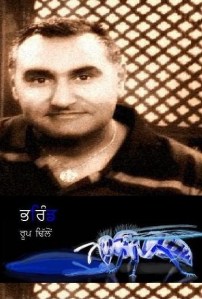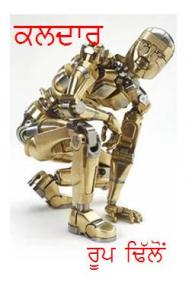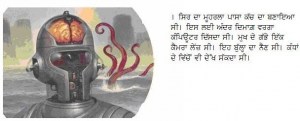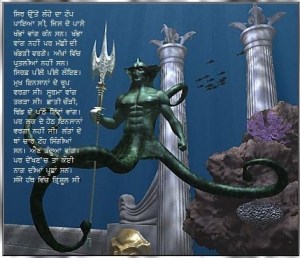Roop Dhillon’s ‘Bharind’
– Book Review by Rajinder Bhachu
Bharind
Poems and Short Stories
By Roop Dhillon
Lahore Publishers
Ludhiana 2011
ISBN: 978-81-7647-283-8
 Roop Dhillon is not a writer. He is an artist. The words one reads, the sentences structured are surreal, rebellious, and against the laws of grammar. Yet they work very well. He is a writer’s writer. The imagination from his pen creates vivid cinematic poetry and imagery, be it describing the stark social realities for Punjabis, or bizarre and shocking alien terrains. This is quite a feat for two reasons. The first is Roop Dhillon is English born and raised and self taught in Punjabi, the second is his first Punjabi book written ten years ago, although an interesting story, was very very poor in terms of correct Punjabi grammar and syntax. Not that any of his current writings hold him back on experimenting. There is a clear difference between the previous novel, where one can say Roop lacked the Punjabi language, and now, where it is in the western raised Punjabi’s idiom, but no longer irritating to read. I have been privileged to see the work he is currently working on, and can say if Neela Noor is Roop’s Grimus, then the next piece may well be his Midnight’s children. That however will remain to be seen. His latest book, Bharind, is a collection of 15 short stories and 22 patriotic poems. Each story is followed by poems before going onto the next story.
Roop Dhillon is not a writer. He is an artist. The words one reads, the sentences structured are surreal, rebellious, and against the laws of grammar. Yet they work very well. He is a writer’s writer. The imagination from his pen creates vivid cinematic poetry and imagery, be it describing the stark social realities for Punjabis, or bizarre and shocking alien terrains. This is quite a feat for two reasons. The first is Roop Dhillon is English born and raised and self taught in Punjabi, the second is his first Punjabi book written ten years ago, although an interesting story, was very very poor in terms of correct Punjabi grammar and syntax. Not that any of his current writings hold him back on experimenting. There is a clear difference between the previous novel, where one can say Roop lacked the Punjabi language, and now, where it is in the western raised Punjabi’s idiom, but no longer irritating to read. I have been privileged to see the work he is currently working on, and can say if Neela Noor is Roop’s Grimus, then the next piece may well be his Midnight’s children. That however will remain to be seen. His latest book, Bharind, is a collection of 15 short stories and 22 patriotic poems. Each story is followed by poems before going onto the next story.
Ten years of struggling, learning to read and write Punjabi at home, in an area where there are few Punjabi or Asian people, and no Punjabi language teachers, has not resulted in a vain journey. It has produced an unusually titled book, influenced partly by Punjabi authors such as Amrita Preetum, Ajaib Kamal and Shivcharan Jaggi Kussa, but more so from reading English novels ( including I suspect a host of foreign European translations into English) and writers such as Kafka, Graham Greene and Milan Kundera. I suspect that Roop is a huge Hollywood fan, as all his stories have plots not dissimilar to American films, especially futuristic and fantasy ones. The skill in Bharind is bringing all this together in a Punjabi relevant milieu and producing possibly a new genre of writing in the language. Roop is a pioneer who blends traditional Punjabi techniques and idioms with western influenced ideas and methods of writing. The result is prose that can compete with international languages.
The subjects covered in the short stories cover many contempory social issues facing Punjabis, from farmers who hang themselves, drug addicts to the much denied incest issue. The stories and poems are also unashamedly proud of Punjabi as a language, criticizing those who choose English, Urdu and Hindi over a much maligned tongue. There is also the questioning of identity, by the western born Punjabi. Am I eastern or western? The final story, Speed, compares vividly with minimal effort and description the changing landscape of Punjab and aspirations of the new generation, contrasted with regrets of the old. Let us examine each story in brief.
The first story is Laal Lehar, which is very direct and to the point. It is about the sexual abuse of a girl by her chacha. The story is written in the first person and quickly winds the heart of the reader. It uses a mix of Punjabi colloquialism and short sharp sentence structure seen in modern English literature. The techniques are similar to John Banville’s and sometimes have to be read twice. Roop mixes the regional accents of Malwi, Doabi and Majdi Punjai with Lanhdi and English. There is some use of Hindi and Urdu as well, but an acceptable level. This occurs thorough out the prose, but I think is acceptable as no living languages survives if it does not change to reflect the usage of its speakers or absorbs new words from outside sources. There is a shocking ending literally, which will throw those off that are only use to reading village based literature or like Indian TV dramas.
The second story is Daaj denh daa nateja. As the title suggests this tale deals with the realities of a dowry and the consequences from the view again of the woman. It is familiar and comfortable, which is I suspect why Roop wrote it. The third story is a complete departure from anything that has ever been written in Punjabi. Although again it is an issue based story, Kaldaar introduces a new word into the Punjabi lexicon, Kaldaar which we soon realise refers not only to robots, but machinery with an intelligence that is down trodden and used by man for toil. Influenced strongly by Asimov, this is a story about caste, prejudice and slavery. The Robots as described could easily be the Bhayyias, a disdainful word to describe Biharis, seen as invading Punjab, or they could be the Dalit class, rising against the system. This is quite timely considering what has been happening with the Chammar community in real life in the Jalandar area. But again, the twist is not the retelling of a story already told by a western writer, but a shocking reveal about what could happen to the majority population of India; the poor, as food resources decline. Again, I will leave the reader to find out for themselves.
 The next story is Vikaas, an amazing sweep of the imagination that mixes social concerns of the Punjab, with eco-global concerns of the rest of the world. I think the title is meant to be ironic, as the tale shows a world at its end, sending out many spacecraft to look for another habitable planet. The description of the journey and the new world is sublime and beautiful. Traditional Punjabi sentence structure is twisted until it is as alien as the world, but produces beautiful imagery. Vikaas shows how a Pancheyt on another world judges man. Man’s mind is used to project history of Homo Sapiens like a film, showing the true dark nature of the beast. His attitude towards woman, race and war. The ending is truly sad.
The next story is Vikaas, an amazing sweep of the imagination that mixes social concerns of the Punjab, with eco-global concerns of the rest of the world. I think the title is meant to be ironic, as the tale shows a world at its end, sending out many spacecraft to look for another habitable planet. The description of the journey and the new world is sublime and beautiful. Traditional Punjabi sentence structure is twisted until it is as alien as the world, but produces beautiful imagery. Vikaas shows how a Pancheyt on another world judges man. Man’s mind is used to project history of Homo Sapiens like a film, showing the true dark nature of the beast. His attitude towards woman, race and war. The ending is truly sad.
As if to provide relief from these fantastical stories, Laash sticks to the real world and an apparent suicide in modern Ludhiana. It is a distraction from the more amazing stories but familiar in its content. It’s like Roop was afraid to lose the typical Punjabi reader, and felt he needed to return back to themes often explored in Punjabi novels. It was a relief for me then, when Dunga Paani, took me back into the crazy and fantastic mind of Mr Dhillon. The title says it all. But this is different from both previous pieces of Science Fiction. It is psychological, dealing with how a woman copes with the death of her drowned child, this time in a futuristic Ludhiana. Like the previous story, it has elements of a detective story. The main character is called Heer after Waris Shah’s heroine. Despite he fear of water since the event she is sent deep into the sea to investigate the death of a Scientist called Kaido, who is part of a team searching for a replacement for oil. The ecological themes mix with Heer’s own feelings. The real twist is that all the characters are named after famous couples and their associates from Qissas. Mirza and Sahiban appear as well as others who have their traditional roles reversed. This Heer’s son in this story is named after the father from the Qissa. The story is good enough and tense enough to be made into a film and is my personal favourite. As before there is an unexpected filmi twist.
 Shohdi Istari is perhaps the shortist story, more a mini kahani. Again it deals with the treatment of women, in a very poetic and beautiful way. To say more will be to say too much. It is followed by a similar type of story, Viaah da nateja. Both are set in the real familiar world. The next story, Piaar Da Naa Manjoor Saroop, completes the trilogy about female treatment. However this time it is set in Harrappa in the far past, where Roop re-imagines an open minded society on the verge of its fall into the repressed Indus Valley of today. This story is actually online and has so far had over 4,000 hits, possibly making it his most popular short story. The reason? It is taboo. It is the story of two women in love, a condition deemed unnatural. It is not sexually explicit or exploitative but is erotic.
Shohdi Istari is perhaps the shortist story, more a mini kahani. Again it deals with the treatment of women, in a very poetic and beautiful way. To say more will be to say too much. It is followed by a similar type of story, Viaah da nateja. Both are set in the real familiar world. The next story, Piaar Da Naa Manjoor Saroop, completes the trilogy about female treatment. However this time it is set in Harrappa in the far past, where Roop re-imagines an open minded society on the verge of its fall into the repressed Indus Valley of today. This story is actually online and has so far had over 4,000 hits, possibly making it his most popular short story. The reason? It is taboo. It is the story of two women in love, a condition deemed unnatural. It is not sexually explicit or exploitative but is erotic.
We race off like Michael J Fox in a time travelling car in the next tale, Chori Da Nateja, which deals with out a thief is punished after his gang rob a post office, followed by Canadian Gangster which is wholly set in reality. The latter depicts the effects of drugs, guns and car accidents on the children of the Punjabi community as they helplessly watch the ‘Brown on Brown’ crime. The next story, Dil Diaah Peerhan, is more traditional, as it deals with a woman’s thoughts on her life and relationship with her children and husband. This might possibly be the weakest tale, and I suspect autobiographical in some way. I understand this was the first story Roop wrote after Neela Noor, so I am not surprised. It is followed by another story set in the real world, Rang. This is an experimental piece about a thief. Roop attempts to use language to paint a picture in our minds by colouring the scenery. The main character may in one scene be dressed in red, in a red room where everything else is red. This should give you an idea of the kind of story it is. I shall leave it to you to judge whether the experiment works or not. Colourful, it certainly is.
Mulakat is the next tale, set in a dhaba, it is an interview of a man’s memories of 1947, and the events in a particular village where Hindus and Muslims lived in relative peace and harmony, except that two criminal families exist. Each is hell bent on destroying the other. One happens to be led by a Muslim, the other a Hindu. The tense environment is strained further when an unnamed Nihang walks into the town and offers his services to the Muslim gang, after being racially abused by the Hindu one. The amoral choices he makes hide his true intentions from both gangs.
The penultimate story is Bharind. This is Kafkaesque and disturbing. Wonderful, yet frightening images are constructed in the mind, as the reader is left to decide whether Heera, the protagonist is a victim of some alien bite, transforming into a hornet, or whether he is on a bad drip due to years of abusing drugs. It is not quite like Metamorphosis as it is not so much Heera turning as the whole world around him. His drug dealer, his mother sister and brother – in – law. The story indirectly deals with drug abuse, and shows how it can warp the mind and finally destroy a human being. Heera is from a tragic family, the father having hung himself when he could not pay debts. But instead of working hard to pay them off, he spends all he has on drugs. The result is his sister has to take up the slack and throws him out, despite her mother’s protestations. Heera wonders the streets, ruthlessly even robbing the poor, constantly hearing a buzzing in his mind. He is today’s Punjabi youth, sadly.
 The final story, Speed is a masterpiece in skilful writing. Where Bharind relies on detailed imagery, and use of powerful but descriptive words almost filming the tale in ones head, as one sees the horrors that Heera does, Speed is simple short and effective. Where a lot happens in Bharind ( Potentially another film plot), with many gloriously described scenes, helping to create character, all that happens in the last story is two individuals travel in a car from the village to the city. Yet in that time we see both their thoughts as they look out of the car window at Punjab speeding past, with all its changes as it progresses from Pind to Shair. In a few paragraphs we see the lamentations of the old passenger seeing his world wisp away, and the youngster looking forward to the modern world, as mile after mile the scene outside becomes more and more urban. In this idea Roop catches the changes in Punjab poetically.
The final story, Speed is a masterpiece in skilful writing. Where Bharind relies on detailed imagery, and use of powerful but descriptive words almost filming the tale in ones head, as one sees the horrors that Heera does, Speed is simple short and effective. Where a lot happens in Bharind ( Potentially another film plot), with many gloriously described scenes, helping to create character, all that happens in the last story is two individuals travel in a car from the village to the city. Yet in that time we see both their thoughts as they look out of the car window at Punjab speeding past, with all its changes as it progresses from Pind to Shair. In a few paragraphs we see the lamentations of the old passenger seeing his world wisp away, and the youngster looking forward to the modern world, as mile after mile the scene outside becomes more and more urban. In this idea Roop catches the changes in Punjab poetically.
In addition to the 15 stories there are over a score of poems, lamenting over the under use of Punjabi to the treatment of women. I think it inappropriate to go through each one of these. Needless to say there are some beautiful gems amongst the poems, and one or two that may even become classics.
It would not surprise me if in a matter of months Bharind became a study text. It is truly that good, and quite possibly the best collection of short stories in ten years, sprinkled with many good poems for size. It is at once an issue based book, lamenting the state of Punjabyat, and dealing with gender, caste and abuse; whilst on the other hand offering up a new genre in Punjabi Literature which fits in better with the Harry Potter reading new generation in India, with its I-pods, aliens and drug induced hallucinations. This is quite possibly a beginning of a new kind of Punjabi Genre that may kick start life again in to a language which needs it. The release is timely as their seems to be a revival for all things Punjabi at the moment.
Twenty years ago Alaap and Heera made Punjabi music sexy, resulting in a new kind of sound imported into India from the UK. Now quite possibly the same might happen with Literature. I thoroughly recommend serious readers of Punjabi have a copy of Bharind on their bookshelves. I predict with time, Roop Dhillon may become a significant and recognised writer.
 Book is available from
Book is available from
Lahore Book Shop
Ludhiana
.
.Book publishers, distributors & exporters
2, Lajpat Rai Market
Near Society Cinema,
Ludhiana – 141008,
Punjab, India.
Phone: +91-161-2740738
info@lahorepublishers.com
lahorebookshop40@rediffmail.com
Reviewer’s opinions are her own.